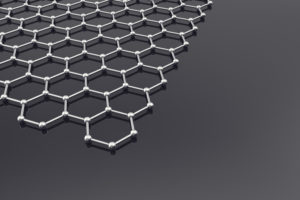
The future of lightweight composites lies at the intersection of strength and innovation. Across various industries such as aerospace, automotive, and advanced engineering, the demand for stronger, lighter, and more efficient materials is higher now.
This is where carbon fibre composites have led the charge. Known for their exceptional strength-to-weight ratio and stiffness, they’ve become a go-to solution for everything from Formula 1 cars to next-generation aircraft wings. But as engineers seek to push the envelope even further, graphene is changing the way we think about composite reinforcement.
When graphene is combined with carbon fibre, it produces a new form of high-performance material that is stronger, tougher, and more versatile.
So, how exactly does graphene strengthen carbon fibre? Let’s explore the remarkable synergy between these two carbon-based materials and uncover why graphene in composite materials is the next big step forward in structural performance.
What is Graphene?

Graphene is a single layer of carbon atoms arranged in a two-dimensional honeycomb structure. It’s incredibly thin, just one atom thick, yet astonishingly strong.
Graphene holds the title of the strongest material ever measured, with a tensile strength of around 130 GPa and a Young’s modulus (stiffness) of about 1 TPa.
That makes it over 100 times stronger than steel, while remaining exceptionally lightweight and flexible.
Graphene also has exceptional thermal and electrical conductivity. It can conduct heat better than most metals and allows electrons to flow freely across its surface, making it ideal for advanced applications where both mechanical and functional performance are required.
By incorporating graphene at the nanoscale, we can dramatically improve a composite’s resistance to crack propagation, heat transfer, and even electromagnetic interference, without sacrificing weight or manufacturability.
As a result, graphene in composite materials is rapidly becoming a must-have feature in modern high-performance materials, offering smarter, more durable, and more efficient solutions for tomorrow’s engineering challenges.
Ways Graphene Strengthen Carbon Fibre Composites?
Graphene is a powerhouse material that brings an impressive suite of enhancements when added to carbon fibre composites. Let’s explore exactly how graphene strengthens carbon fibre across multiple performance areas.
1. Enhanced Carbon Content
Graphene is made entirely of carbon. When it’s added to a carbon fibre matrix, it increases the overall carbon density at the micro and nanoscale.
By introducing graphene carbon fibre reinforcement, engineers can improve the composite’s stiffness and strength without increasing its weight. This acts as a critical advantage in industries where every gram matters.
The extra carbon provided by graphene helps lightweight composites perform under greater stress, resist deformation, and maintain their shape over longer service lives.
2. Improved Polymer Chain Alignment
One of the more fascinating aspects of graphene in composite materials is its influence on polymer alignment. As the composite cures, graphene sheets can guide polymer chains to align in a more ordered structure.
Why does this matter?
Well-aligned polymer chains create a more cohesive and structurally sound material. This leads to
- Better load transfer across the matrix
- Fewer weak points where failure might begin
- A smoother, more uniform material throughout
3. Increased Fracture Toughness
Another critical performance measure in composite materials is fracture toughness, the ability to resist sudden cracking or catastrophic failure.
When cracks begin to form in the matrix, graphene acts as a crack arrester. Its stiff, sheet-like form interrupts the crack propagation path, forcing the crack to either stop or change direction.
This dissipates energy and slows down failure, allowing the structure to absorb more impact without giving way.
By distributing stress and absorbing shock energy, graphene-enhanced composites can endure higher impact loads, which is ideal for use in sports equipment, aerospace skins, and even protective gear.
4. Enhanced Interlaminar Strength
If you’ve ever seen layers of laminate peel apart under pressure, you’ve witnessed a failure of interlaminar strength. This is especially problematic in layered composites such as those used in aircraft fuselages, wind turbine blades, and structural beams.
Graphene offers a smart solution.
When introduced between the layers of a composite, graphene sheets improve interlaminar bonding, effectively tying the layers together more securely. This reduces the risk of delamination, especially in high-vibration or high-impact environments.
Think of it as nano-stitching that holds your layered composite together with surprising tenacity.
The result is a more durable material that can withstand:
- Repetitive loading cycles
- Thermal expansion and contraction
- Mechanical stress from multiple directions
5. Better Thermal Conductivity
One of the lesser-known superpowers of graphene is its incredible thermal conductivity. It’s one of the most thermally conductive materials known to science. When integrated into carbon fibre graphene composites, graphene forms conductive pathways, essentially thermal bridges, through the carbon fibre composites.
This means that heat doesn’t just sit in one spot and cause localised stress or damage. Instead, it gets distributed more evenly across the entire structure.
Modern applications, from electric vehicle battery enclosures to aerospace avionics, generate a lot of heat.
If they’re left unmanaged, that heat can degrade components, reduce performance, and shorten service life.
6. Improved Electrical Conductivity
Standard carbon fibre composites are great for mechanical strength, but they tend to be electrically insulating, not ideal for applications that require conductive materials.
But, when graphene is introduced into the carbon fibre composition, graphene transforms CFRPs (Carbon Fibre Reinforced Polymers) from electrical insulators into semi-conductors or even full conductors.
With graphene carbon fibre composites, you can integrate:
- Lightning strike protection in aerospace applications
- Sensor systems in automotive and industrial automation
- Embedded circuits in smart devices
This presents opportunities for “multi-functional” composites, materials that are structurally strong and also electrically active.
7. EMI (Electromagnetic Interference) Shielding
Electromagnetic interference (EMI) could be a serious concern with a lot of connective features in modern tech. From satellites to hospital equipment, any signal disruption can lead to serious consequences.
Graphene naturally absorbs and dissipates electromagnetic waves, making it a reliable EMI shielding material.
When used in graphene carbon fibre composites, it can protect sensitive electronics without relying on traditional metal housings, which are heavy and take up valuable space.
8. Fatigue Resistance
In applications involving constant motion, like robotic arms, suspension systems, or turbine blades, materials are subjected to cyclic stress. Over time, this can cause fatigue cracks to form and spread.
Graphene helps break that cycle.
Its strong, flexible sheets resist the initiation and growth of microcracks, significantly improving a component’s fatigue resistance. It absorbs and redistributes stress before cracks can form or propagate, giving parts a much longer working life.
This is especially important in the following areas
- Aerospace components exposed to vibration
- High-speed automotive parts
- Industrial machinery in round-the-clock operation
9. Corrosion and Moisture Protection
Water ingress is one of the most common and destructive forms of composite failure, particularly in marine environments and industrial settings. But, graphene is almost impermeable to moisture and corrosion.
By forming a tight barrier within the carbon fibre matrix, graphene prevents:
- Water vapour penetration
- Oxidation of internal fibres
- Chemical corrosion of the resin
Why Graphene-Enhanced Carbon Fibre Is the Future of Composites
As we’ve explored, graphene carbon fibre composites represent a significant leap forward in engineering materials. By integrating graphene, one of the strongest and most versatile nanomaterial reinforcements available, into the carbon fibre composites, we gain far more than just added strength.
We get:
- Improved fracture toughness and interlaminar strength
- Enhanced thermal conductivity and electrical conductivity
- Greater durability in harsh environments
- Lighter, smarter materials that outperform traditional composites
In summary, graphene doesn’t just reinforce carbon fibre, it transforms it. From aerospace to automotive, defence to diagnostics, graphene in composite materials is opening up new possibilities for safer, more efficient, and longer-lasting designs.
And this is just the beginning.
As manufacturing processes become more refined and cost-effective, we’ll see wider adoption of carbon fibre and graphene reinforcement across mainstream industries.
These materials will move from specialised applications into everyday engineering, offering smarter, scalable solutions to age-old challenges in structural design and energy efficiency.
If you’re looking for a high-performance material that delivers strength, functionality, and sustainability, graphene-reinforced composites could be the smart way forward.
Reinforce Your Next Project With Advanced Composites Engineering
At Advanced Composite Engineering, we’re more than just suppliers; we’re your trusted partner in materials innovation. If you’re developing critical aerospace components or exploring smarter structural solutions for the automotive, marine, or industrial sectors, our graphene-enhanced technologies are designed to help you achieve the next level of performance.
We offer expert guidance on integrating graphene in composite materials tailored to your specific application. If you’re looking for custom carbon fibre tubes reinforced with graphene, we can help you find the perfect fit.
Our reliable carbon sleeves are engineered for strength, flexibility, and long-term reliability, making them ideal for demanding environments.
You can also explore our comprehensive Composite Glossary to better understand the materials, methods, and terminology involved in advanced composites.
Ready to take the next step? Use our quick enquiry form to request a bespoke quote. Just tell us your project requirements, and we’ll take care of the rest. For questions around material selection, tube sizing, lead times, or anything in between, don’t hesitate to contact us. Our experienced team is here to provide clear, expert support.
FAQs about Graphene in Carbon Fibre Composites
1. Can graphene replace carbon fibre?
No. Graphene is used to enhance, not replace, carbon fibre. While graphene offers remarkable properties, it doesn’t have the long structural form needed to carry primary loads in large components. Instead, it works synergistically with carbon fibres to boost performance across the composite.
2. Does graphene reduce heat properties in carbon fibre?
Not at all. Graphene significantly improves thermal conductivity. It forms microscopic pathways that help distribute heat more evenly across the material, making it perfect for applications that require cooling, such as battery housings and electronic components.
3. Can graphene protect from UV?
Yes. Graphene acts as a UV barrier, shielding the carbon fibre matrix and polymer resins from sun damage. This helps maintain the composite’s strength and appearance over time, making it ideal for outdoor and aerospace applications.
4. Does graphene replace carbon fibres or just enhance them?
Graphene simply enhances them. It improves the bonding within the matrix, boosts interlaminar strength, and adds conductive properties, without replacing the core fibres. It’s the ultimate performance upgrade, not a substitute.
5. How does graphene improve carbon fibre strength at such low concentrations?
Thanks to its high surface area and extraordinary mechanical properties, even small amounts of graphene (as little as 0.1–0.5% by weight) can reinforce the composite. It bridges micro-cracks, aligns polymer chains, and enhances stress transfer, all while working efficiently at the nanoscale.



